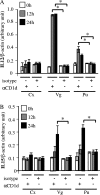Expression of CD1d and ligand-induced cytokine production are tissue specific in mucosal epithelia of the human lower reproductive tract
- PMID: 18458073
- PMCID: PMC2446716
- DOI: 10.1128/IAI.01672-07
Expression of CD1d and ligand-induced cytokine production are tissue specific in mucosal epithelia of the human lower reproductive tract
Abstract
Mucosal epithelia of the human lower reproductive tract (vagina, cervix, and penile urethra) are exposed to sexually transmitted microbes, including Chlamydia trachomatis. The in vivo susceptibility of each tissue type to infection with C. trachomatis is quite distinct. CD1d is expressed on the surface of antigen-presenting cells, including mucosal epithelial cells, and interacts specifically with invariant NKT cells. Invariant NKT cells play a role in both innate and adaptive immune responses to microbes. Here we assessed CD1d expression in normal reproductive tissues by using immunohistochemistry. Immortalized epithelial cell lines from the human lower reproductive tract (vagina, endocervix, and penile urethra) were examined for CD1d expression and for ligand-induced cytokine production induced by CD1d cross-linking. CD1d expression in normal tissue was strong in the vagina but weak in the endocervix and penile urethra. Gamma interferon exposure induced CD1d transcription in all of the cell types studied, with the strongest induction in vaginal cells. Flow cytometry revealed cell surface expression of CD1d in vaginal and penile urethral epithelial cells but not in endocervical cells. Ligation of surface-expressed CD1d by monoclonal antibody cross-linking promoted interleukin-12 (IL-12) and IL-15, but not IL-10, production in vaginal and penile urethral cells. No induction was demonstrated in endocervical cells. CD1d-mediated cytokine production in penile urethral cells was abrogated by C. trachomatis infection. Basal deficiency in CD1d-mediated immune responsiveness may result in susceptibility to sexually transmitted agents. Decreased CD1d-mediated signaling may help C. trachomatis evade detection by innate immune cells.
Figures






Similar articles
-
CD1d degradation in Chlamydia trachomatis-infected epithelial cells is the result of both cellular and chlamydial proteasomal activity.J Biol Chem. 2007 Mar 9;282(10):7368-75. doi: 10.1074/jbc.M610754200. Epub 2007 Jan 10. J Biol Chem. 2007. PMID: 17215251
-
Differential profiles of immune mediators and in vitro HIV infectivity between endocervical and vaginal secretions from women with Chlamydia trachomatis infection: a pilot study.J Reprod Immunol. 2013 Sep;99(1-2):80-7. doi: 10.1016/j.jri.2013.07.003. Epub 2013 Aug 8. J Reprod Immunol. 2013. PMID: 23993451 Free PMC article.
-
Chlamydia trachomatis infection results in a modest pro-inflammatory cytokine response and a decrease in T cell chemokine secretion in human polarized endocervical epithelial cells.Cytokine. 2013 Aug;63(2):151-65. doi: 10.1016/j.cyto.2013.04.022. Epub 2013 May 11. Cytokine. 2013. PMID: 23673287 Free PMC article.
-
Potential mechanisms for increased HIV-1 transmission across the endocervical epithelium during C. trachomatis infection.Curr HIV Res. 2012 Apr;10(3):218-27. doi: 10.2174/157016212800618093. Curr HIV Res. 2012. PMID: 22384841 Free PMC article. Review.
-
Antimicrobial peptides in the female reproductive tract: a critical component of the mucosal immune barrier with physiological and clinical implications.Hum Reprod Update. 2015 May-Jun;21(3):353-77. doi: 10.1093/humupd/dmu065. Epub 2014 Dec 29. Hum Reprod Update. 2015. PMID: 25547201 Review.
Cited by
-
Technical advance. Measurement of iNKT cell responses at the single-cell level against rare HIV-1-infected dendritic cells in a mixed culture.J Leukoc Biol. 2013 Mar;93(3):449-55. doi: 10.1189/jlb.1012489. Epub 2012 Dec 21. J Leukoc Biol. 2013. PMID: 23264676 Free PMC article. Clinical Trial.
-
Unraveling the Phenotypic States of Human innate-like T Cells: Comparative Insights with Conventional T Cells and Mouse Models.bioRxiv [Preprint]. 2023 Dec 8:2023.12.07.570707. doi: 10.1101/2023.12.07.570707. bioRxiv. 2023. Update in: Cell Rep. 2024 Sep 24;43(9):114705. doi: 10.1016/j.celrep.2024.114705. PMID: 38105962 Free PMC article. Updated. Preprint.
-
Chlamydial intracellular survival strategies.Cold Spring Harb Perspect Med. 2013 May 1;3(5):a010256. doi: 10.1101/cshperspect.a010256. Cold Spring Harb Perspect Med. 2013. PMID: 23637308 Free PMC article. Review.
-
CD1d, a sentinel molecule bridging innate and adaptive immunity, is downregulated by the human papillomavirus (HPV) E5 protein: a possible mechanism for immune evasion by HPV.J Virol. 2010 Nov;84(22):11614-23. doi: 10.1128/JVI.01053-10. Epub 2010 Sep 1. J Virol. 2010. PMID: 20810727 Free PMC article.
-
Role of Tonsillar Chronic Inflammation and Commensal Bacteria in the Pathogenesis of Pediatric OSA.Front Immunol. 2021 Apr 29;12:648064. doi: 10.3389/fimmu.2021.648064. eCollection 2021. Front Immunol. 2021. PMID: 33995367 Free PMC article.
References
-
- Behar, S. M., and S. A. Porcelli. 2007. CD1-restricted T cells in host defense to infectious diseases. Curr. Top. Microbiol. Immunol. 314215-250. - PubMed
-
- Bilenki, L., S. Wang, J. Yang, Y. Fan, A. G. Joyee, and X. Yang. 2005. NK T cell activation promotes Chlamydia trachomatis infection in vivo. J. Immunol. 1753197-3206. - PubMed
-
- Blumberg, R. S., C. Terhorst, P. Bleicher, F. V. McDermott, C. H. Allan, S. B. Landau, J. S. Trier, and S. P. Balk. 1991. Expression of a nonpolymorphic MHC class1-like molecule, CD1D, by human intestinal epithelial cells. J. Immunol. 1472518-2524. - PubMed
-
- Bonish, B., D. Jullien, Y. Dutronc, B. B. Huang, R. Modlin, F. M. Spada, S. A. Porcelli, and B. J. Nickoloff. 2000. Overexpression of CD1d by keratinocytes in psoriasis and CD1d-dependent IFN-γ production by NK-T cells. J. Immunol. 1654076-4085. - PubMed
Publication types
MeSH terms
Substances
Grants and funding
LinkOut - more resources
Full Text Sources
Other Literature Sources

